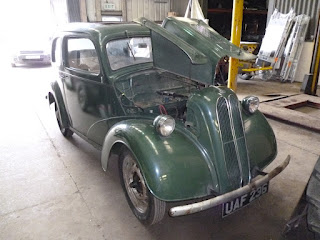
General news roundup – a new car, Lewin and the Forcett coach…
Below: A rear view of the car…
Below: Brian and Tom have been busy reassembling 196’s truck, subsequently adding the motors to the refurbished truck. Various items still need final painting, but reassembly will enable the body to be re-mounted onto the truck, to enable the overhaul to proceed…
Below: The new injectors for Lewin, one complete (rear) and one partially dismantled for the photograph. This shows the delivery cone components, related spacers and retaining collar stretched out across the front of the main injector body. Steam is supplied at the left hand side of the foremost injector, the water arrives at what is the bottom in this view (the flanged section) and the overflow is at the top.
Below: The other end, where the steam arrives, through the removed (steam) cone. Internally the combining cone, the point at which the steam and water meet and mix, can be seen. The transfer of the heat energy from the condensing steam (caused by meeting the cold water) into kinetic energy is at the heart of the injector’s working principle. The delivery cone reverses the process, turning the kinetic energy (essentially, the speed) into pressure, greater than that in the boiler and which supplied the steam to the injector in the first place – it shouldn’t work, but it does!
Below: The rear end of the loco has been somewhat vexatious. The reality of the engine has not corresponded entirely with the drawings as derived from the many photographs. This is largely attributable to the various rebuilds and modifications that No.18 received over its working life. Key to the change in datum, I think, is that the handbrake column is now considerably lower than it would have been in 1936. This could be blamed on the 1977 ‘restoration’ this engine received, but it means that in order to allow sufficient clearance for the handle to rotate, the cab back sheet is lower than it should be. This effect is made more noticeable by eye-reference to the height of the bunkers and ultimately the position of the handrails. What will therefore have to be derived is a period solution, but with the caveat to historians and modellers, that the rear sheet is not exactly as it was in 1936 – however the drawings and the Conservation Management Plan will record this and present the ‘ideal’ alternative for those requiring a definitive historical source. The buffer beam and buffer pads are yet to be fitted, but some adjustment may be required to the rear sheet fittings in order to accommodate these, as obviously buffer heights are a set height in order to be compatible with other rolling stock. the front end of the engine, which has been less modified over the years, provides a useful comparison and reference for this area. By the end of to days session the bunkers had been undercoated in ‘mid green’ high-build undercoat from Craftmaster Paints.
Below: An example of the restoration work – the bottom of this end pillar has had a new section grafted in – once painted and wood grained the effect should be seamless.
Below: An interior view, showing new roof hoops, some of the panelling in place (temporarily) and the new floor fitted.
Below: And finally, a shot of the end (non-brake) showing the coach taking shape…







Recent Comments